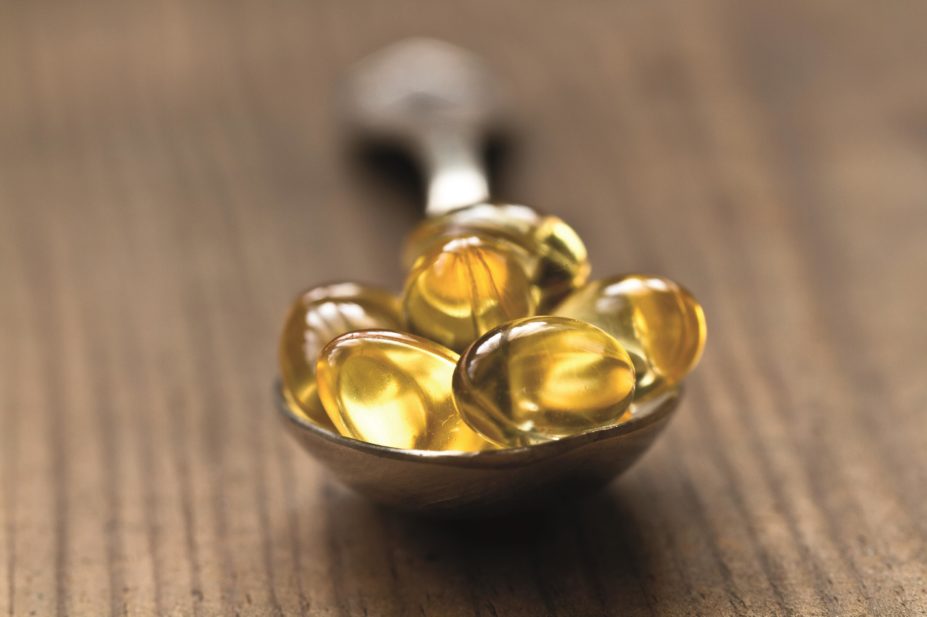
Shutterstock.com
Living in the UK affects the health of almost all of us in one respect: a shortage of sunshine, which is required in order for our skin to produce vitamin D. In 2015, the ODIN study group (an EU-funded project comprising a multidisciplinary team of 31 partners from 19 countries in Europe and the United States) found that the prevalence of vitamin D deficiencies among 55,844 European people was just over 40%[1]
. It is no surprise, then, that many people supplement their diet by purchasing vitamin D either on its own or as part of a multivitamin.
Many healthcare professionals recommend taking vitamin D supplements to address inadequate vitamin D levels. As part of this process they will assess each individual and their needs to ascertain whether the supplement is safe and which dose is appropriate. These measures are important to avoid inadvertently harming the patient. For example, kidney damage can be caused by inappropriate or overconsumption. The risk of inappropriate use and harm increases as more people buy vitamin D supplements over the counter without professional advice.
Ideal intake: not so simple
The importance of vitamin D, which is a member of the steroid family of molecules, has never been underestimated. Cod liver oil, a rich source of vitamin D, has been used to prevent rickets in the UK and was given to starving children in European hospitals before 1920[2]
. By 1931, vitamin D was incorporated into milk and margarine[3]
. During the 1940s, fish oils were a component of British rations, provided according to need, with pregnant women, breastfeeding mothers and children at the top of the list. This classification was challenged at the time because certain groups of adults, including pilots and those working in munitions factories, claimed they too deserved these supplements on the grounds that they required optimal eyesight[4]
.
The empirical approach of recommending foods rich in certain vitamins has developed alongside the idea that different individuals require different levels of vitamins. In the 1990s dietary reference intake or value (DRI or DRV) were introduced internationally to facilitate the labelling of foods so consumers could estimate how to meet their needs for a range of micronutrients, including vitamin D, but such estimates have wide error margins. Minimal or sufficient levels are easily established, but levels for excessive intake – especially for vitamin D – are not so easy to identify because individuals vary significantly in their metabolism and sensitivity to particular vitamins. The quality of data used to estimate these figures has also been questioned because there are relatively few high quality trials in this area[5]
. The recommended daily intake (RDI) for vitamin D has tended to increase since its first publication. Moreover, recommending a vitamin D supplement is not easy because it is manufactured in the skin in response to sunshine. The effectiveness of this photosynthesis — a process some 500 million years old in evolutionary terms — depends on time spent outdoors, age, skin colour and the use of various skin products. The process is regulated by the body so that one cannot synthesise toxic levels of vitamin D in the skin. Studies of many populations have shown that there are significant genetic and ethnic variations in human metabolism of vitamin D, and the extent of these is still being investigated. For example, people with darker skin normally require longer time exposure to sunshine to produce vitamin D in their skin. Overall, it is clear that some people are more sensitive to vitamin D than others[6]
.
National guidelines for vitamin intakes have striking differences. For infants up to six months old in the United States and Canada, for example, the RDI is 400 IU (10μg). In Australia, the RDI is 200 IU (5μg) and, in recent recommendations from the European Food Safety Agency, the RDI is 600 IU (15μg)[7]
. In the UK, expert recommendations on nutrition are given by the Scientific Advisory Committee on Nutrition (SACN), whose recommendation for this age group is 400 IU (10μg). Its most recent recommendations on vitamin D were published in 2015, and the consultation inputs are currently being evaluated. The outcome of this appraisal will be used to revise the UK National Institute for Health and Care Excellence guidelines.
Too much of a good thing?
Taking too much vitamin D raises blood calcium, causing hypercalcaemia, which, in the short term, causes muscle weakness, fatigue, headache, nausea and bone pain. Over time, a loss of appetite and irritability with polydipsia and polyuria, hypertension and cardiac arrhythmias can develop. Hypercalcaemia leads to calcification of the kidneys (nephrocalcinosis) and a long-term risk of kidney stones. It is likely to have other effects, but genetic variations make generalisations on long-term health effects difficult to quantify. For this reason, many governments have recommended a ‘tolerable upper limit’ for vitamin D.
Overdosing and toxicity with vitamin D is clearly documented among those taking supplements. In some situations, the supplements were incorrectly labelled and, in some instances, the consumers may have taken too much or given high doses to their children[8],[9],[10],[11]
.
The National Poison Data System in the United States has provided data of poisoning by vitamin D. Annual reports of toxicity from vitamin D recorded 4,728 cases in 2015 from individuals taking just a vitamin D supplement. There were other cases related to taking multivitamins containing vitamin D. There were no deaths in the cohort but 19 people required hospital treatment[12]
. In these statistics a retrospective analysis from 2000 to 2014 showed 196 cases a year of vitamin D poisoning before 2005 and since then the numbers have increased progressively to 4,535 in 2014[13]
. This increase parallels the growth in self supplementation and appears to document that too much of a good thing can have measurable consequences.
Supplements: help or hindrance?
The marketing of health supplements has evolved, with new terms such as ‘neutraceuticals’, ‘phood’ and tropes linking food with medicines. Manufacturers attempt to persuade consumers that supplements, such as vitamin D, may function as pharmacological agents or prescribed treatments. Under European legislation, products containing vitamin D are permitted to make health claims relating to bones, muscle, teeth, the immune system and cellular health.
According to research by the UK Food Standards Agency, in 2008, nearly one third of people in the UK take some sort of vitamin, mineral or dietary supplement on most days, with 15% reporting that they have taken a “high dose” supplement in the past 12 months. A study of 4,000 volunteers in Denmark showed that six out of ten participants took at least one mineral or vitamin supplement. In all cases there were sufficient levels of this mineral or vitamin in their diet[14]
.
However, even well labelled supplements, together with recognised and regulated health claims, are unlikely to help people resolve their vitamin D deficiency.
As the self-supplement market has grown in the past five years, hospitals have reported rising problems with food poverty, including admissions of children with malnutrition. Impoverished groups in many countries have been found to have compromised nutrition because they could not afford healthy food[15]
[16]
.
In the UK, the Healthy Start initiative replaced the Welfare Food Scheme in 2006 in an attempt to tackle malnutrition by providing vitamins and food supplements to pregnant women, breastfeeding mothers and their infants[17]
. In the United States, the Women’s Initiative Committee initiatives, which started in the 1970s, have been more successful in improving diet quality in the same groups[18]
. Neither initiatives has demonstrated success so far in solving the problem of vitamin D deficiency.
If supplements do not work well for sectors of the population, fortification may be a valuable strategy. Added vitamin D to commonly consumed foods, such as milk and flour, has been shown to be partially effective for populations in Scandinavia and Canada by reducing the worst effects of vitamin D deficiency in those who cannot afford supplements. So perhaps in the ideal world of precision public health, this approach will assist many who cannot afford supplements, while supplements themselves need to be taken carefully rather than recklessly.
Risks and benefits
In order to reduce the risk associated with self-supplementation of vitamin D, we need more robust systems and intelligence to advise people on whether they need to purchase a supplement or not. Pharmacists are well positioned to help people choose which supplements would be safe and beneficial for them, while computer systems or apps could also assist with this. This could be a rich area for biotechnology developments within the NHS, given the sizes of these markets. Specific apps could be developed to allow individuals to choose their supplements when they visit a pharmacy or supermarket. These could interrogate a customer, collecting dietary and health data then providing advice on selections of appropriate and safe doses of the various vitamins available. This approach should, in theory, prevent overdosing while ensuring wiser selection and therefore be appealing to public health doctors, pharmacists and the vitamins and supplements industry. Perhaps there is a role for governments to develop such informed supplementation systems to enhance health.
There is sufficient high quality data to permit healthcare professionals to provide recommendations on how much supplemental vitamin D an individual requires. People need to assess other elements of added vitamin D that can be consumed as part of a healthy diet, such as through fortified foods, and then take the remainder of their recommended daily intake as an oral supplement. If there is any doubt that intakes of other micronutrients or perhaps calcium may be a problem, it would be worthwhile to consult a pharmacist, doctor or dietician. Although vitamin D supplementation may benefit some, getting the right amount to the right individual is more challenging. Optimum intakes of micronutrients, particularly vitamin D, will surely improve public health.
Colin Michie is a paediatrician with a special interest in nutrition working at Ealing Hospital, London. He is a former chair of the Nutrition Committee of the Royal College of Paediatrics and Child Health.
References
[1] Cashman KD, Dowling KG, Å krabáková Z et al. Vitamin D deficiency in Europe: pandemic? Am J Clin Nutr 2016;103:1033–1044. doi: 10.3945/ajcn.115.120873
[2] Report on the present state of knowledge of Accessory Food Factors. MRC report to the Privy Council (HMSO). 1924.
[3] Lawrence M. Food Fortification. Oxford: Oxford University Press; 2013.
[4] Report of the Welfare Foods Division November 1949. MH 156/544.
[5] Vieth R. Vitamin D toxicity, policy, and science. J Bone Miner Res 2007;22:V64–V68. doi: 10.1359/jbmr.07s221
[6] Christakos S, Dhawan P, Verstuyf A et al. Vitamin D: metabolism, molecular mechanism of action, and pleiotropic effects. Physiol Rev 2016;96:365–408. doi: 10.1152/physrev.00014.2015
[7] European Food Safety Authority. Scientific opinion on dietary reference values for vitamin D1 (draft). Available at: http://www.efsa.europa.eu/sites/default/files/consultation/160321.pdf
[8] Taussig HB. Possible injury to the cardiovascular system from vitamin D. Ann Intern Med 1966;65:1195–1200. PMID: 5333232
[9] Lowe H, Cusano NE, Binkley N et al. Vitamin D toxicity due to a commonly available “over the counter” remedy from the Dominican Republic. J Clin Endocrinol Metab 2011;96:291–295. doi: 10.1210/jc.2010-1999
[10] Araki T, Holick MF, Alfonso BD et al. Vitamin D intoxication with severe hypercalcemia due to manufacturing and labeling errors of two dietary supplements made in the United States. J Clin Endocrinol Metab 2011;96:3603–3608. doi: 10.1210/jc.2011-1443
[11] Vieth R, Pinto TR, Reen BS et al. Vitamin D poisoning by table sugar. The Lancet 2002;359:672. doi: 10.1016/S0140-6736(02)07814-5
[12] Markestad T, Hesse V, Siebenhuner M et al. Intermittent high-dose vitamin D prophylaxis during infancy: effect on vitamin D metabolites, calcium, and phosphorus. Am J Clin Nutr 1987;46:652–658. PMID: 3499065
[13] Mowry JB, Spyker DA, Brooks DE et al. 2014 annual report of the American Association of Poison Control Centers’ National Poison Data System (NPDS): 32nd Annual Report. Clin Toxicol (Phila). 2015;53:962–1147. Available at: http://www.aapcc.org/annual-reports/
[14] Harrison-Dunn AR. 100% of RDAs is too much of a good thing, Danish researchers warn. Nutraingredients.com. 9 March 2016. Available at: http://www.nutraingredients.com/Regulation-Policy/100-of-RDAs-is-too-much-of-a-good-thing-Danish-researchers-warn#ht=1049
[15] McFadden A, Green JM, Williams V et al. Can food vouchers improve nutrition and reduce health inequalities in low-income mothers and young children: a multi-method evaluation of the experiences of beneficiaries and practitioners of the Healthy Start programme in England. BMC Public Health 2014;14:148. doi: 10.1186/1471-2458-14-148
[16] Soininen S, Eloranta AM, Lindi V et al. Determinants of serum 25-hydroxyvitamin D concentration in Finnish children: the Physical Activity and Nutrition in Children (PANIC) study. Br J Nutr 2016;115:1080–1091. doi: 10.1017/S0007114515005292
[17] National Institute for Health and Care Excellence. Healthy Start vitamins: is a targeted or a universal approach more cost effective? Available at: http://www.nice.org.uk/about/what-we-do/our-programmes/nice-guidance/nice-guidelines/types-of-guideline/additional-publications/healthy-start-vitamins
[18] United States Department of Agriculture Food and Nutrition Service. Women, infants and children (WIC). Available at: http://www.fns.usda.gov/wic/women-infants-and-children-wic


